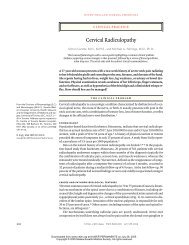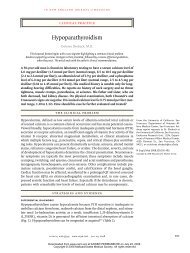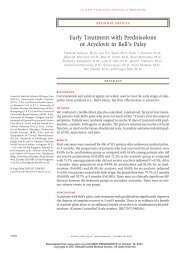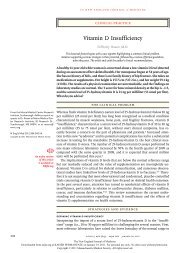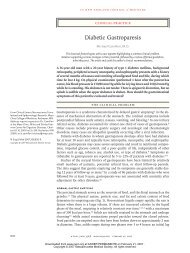Hypertension in Pregnancy 2011.pdf
Hypertension in Pregnancy 2011.pdf
Hypertension in Pregnancy 2011.pdf
Create successful ePaper yourself
Turn your PDF publications into a flip-book with our unique Google optimized e-Paper software.
cl<strong>in</strong>ical pr actice<br />
ilar results for the detection of growth restriction, 36<br />
ultrasonography also assesses amniotic-fluid volume<br />
and fetal movements and tone (biophysical<br />
profile), evaluations that may be useful with respect<br />
to the risks associated with chronic hypertension<br />
<strong>in</strong> pregnancy.<br />
Given the <strong>in</strong>creased risk of stillbirth <strong>in</strong> mothers<br />
with hypertension, 10 surveillance of fetal wellbe<strong>in</strong>g<br />
is also recommended by some experts, although<br />
others recommend restrict<strong>in</strong>g such test<strong>in</strong>g<br />
to pregnancies with complications, such as growth<br />
restriction or preeclampsia. 17,18 Test<strong>in</strong>g may also<br />
<strong>in</strong>clude the evaluation of the pattern and variability<br />
of the fetal heart rate (nonstress test<strong>in</strong>g). Maternal<br />
complications (e.g., preeclampsia or worsen<strong>in</strong>g<br />
hypertension), nonreassur<strong>in</strong>g fetal-test<strong>in</strong>g<br />
results, or concern about fetal growth restriction<br />
are often <strong>in</strong>dications for early delivery. Cl<strong>in</strong>icians<br />
must weigh the risks of fetal morbidity associated<br />
with delivery before term aga<strong>in</strong>st the risks of maternal<br />
and fetal complications from cont<strong>in</strong>ued expectant<br />
management. In women with chronic<br />
hypertension without additional complications,<br />
delivery is often planned near the estimated due<br />
date, although the need for such <strong>in</strong>tervention is<br />
uncerta<strong>in</strong> if test<strong>in</strong>g results are reassur<strong>in</strong>g and fetal<br />
growth is normal.<br />
Breast-feed<strong>in</strong>g<br />
Breast-feed<strong>in</strong>g should be encouraged <strong>in</strong> women<br />
with chronic hypertension, <strong>in</strong>clud<strong>in</strong>g those requir<strong>in</strong>g<br />
medication. Although most antihypertensive<br />
agents can be detected <strong>in</strong> breast milk, levels are<br />
generally lower than those <strong>in</strong> maternal plasma. 37<br />
These relatively low levels and observational data<br />
from series of women who were receiv<strong>in</strong>g medications<br />
while breast-feed<strong>in</strong>g have led the American<br />
Academy of Pediatrics to label most antihypertensive<br />
agents, <strong>in</strong>clud<strong>in</strong>g ACE <strong>in</strong>hibitors, as “usually<br />
compatible” with breast-feed<strong>in</strong>g. 38 S<strong>in</strong>ce case reports<br />
have described lethargy and bradycardia <strong>in</strong><br />
newborns who are breast-fed by mothers tak<strong>in</strong>g<br />
atenolol, the American Academy of Pediatrics recommends<br />
that atenolol be used “with caution.” No<br />
such cautions are noted for other beta-blockers,<br />
such as metoprolol. Because data are lack<strong>in</strong>g with<br />
respect to the use of ARBs and breast-feed<strong>in</strong>g, it is<br />
recommended that other agents be considered for<br />
treat<strong>in</strong>g hypertension <strong>in</strong> lactat<strong>in</strong>g women. Recommendations<br />
from the Society of Obstetricians and<br />
Gynaecologists of Canada note that the use of<br />
long-act<strong>in</strong>g nifedip<strong>in</strong>e, labetalol, methyldopa, captopril,<br />
and enalapril is acceptable dur<strong>in</strong>g breastfeed<strong>in</strong>g.<br />
21<br />
A r e a s of Uncerta <strong>in</strong> t y<br />
Data from randomized trials to <strong>in</strong>form the treatment<br />
of women with chronic hypertension <strong>in</strong> pregnancy<br />
are limited, <strong>in</strong>clud<strong>in</strong>g whether women with<br />
mild-to-moderate hypertension should receive antihypertensive<br />
treatment, which target blood pressure<br />
should be used for treatment, and which<br />
antihypertensive agents are superior for use <strong>in</strong><br />
pregnancy. The Control of <strong>Hypertension</strong> <strong>in</strong> <strong>Pregnancy</strong><br />
Study (CHIPS; Cl<strong>in</strong>icalTrials.gov number,<br />
NCT01192412) is an ongo<strong>in</strong>g randomized trial <strong>in</strong>volv<strong>in</strong>g<br />
women with chronic hypertension or pregnancy-associated<br />
hypertension that is compar<strong>in</strong>g<br />
“less tight” control (target diastolic blood pressure,<br />
100 mm Hg) with “tight” control (target diastolic<br />
blood pressure, 85 mm Hg) with respect to maternal,<br />
fetal, and neonatal outcomes 39 ; study completion<br />
is anticipated <strong>in</strong> 2013. Additional prospective<br />
studies are needed to assess maternal and fetal<br />
outcomes associated with the use of different antihypertensive<br />
therapies and blood-pressure targets.<br />
Long-term follow-up of both mother and offspr<strong>in</strong>g<br />
is also warranted, particularly given the <strong>in</strong>creas<strong>in</strong>g<br />
evidence that the environment <strong>in</strong> utero <strong>in</strong>fluences<br />
later health outcomes. 40<br />
Guidel<strong>in</strong>es<br />
Guidel<strong>in</strong>es for the management of pregnancy <strong>in</strong><br />
women with chronic hypertension have been published<br />
by the American College of Obstetricians<br />
and Gynecologists, 18 the Society of Obstetricians<br />
and Gynaecologists of Canada, 41 the Work<strong>in</strong>g Group<br />
of the National High Blood Pressure Education<br />
Program, 17 and the Australasian Society for the<br />
Study of <strong>Hypertension</strong> <strong>in</strong> <strong>Pregnancy</strong> 29 (Table 2).<br />
These guidel<strong>in</strong>es all emphasize the importance<br />
of preconception plann<strong>in</strong>g and management, recommend<br />
that ACE <strong>in</strong>hibitors be avoided <strong>in</strong> pregnancy,<br />
and emphasize the long experience support<strong>in</strong>g<br />
the safety of methyldopa dur<strong>in</strong>g pregnancy.<br />
However, different guidel<strong>in</strong>es suggest disparate<br />
thresholds for antihypertensive treatment and differ<br />
<strong>in</strong> recommendations regard<strong>in</strong>g certa<strong>in</strong> medications,<br />
<strong>in</strong>clud<strong>in</strong>g whether they endorse the use<br />
of atenolol <strong>in</strong> pregnancy.<br />
n engl j med 365;5 nejm.org august 4, 2011 443<br />
The New England Journal of Medic<strong>in</strong>e<br />
Downloaded from nejm.org at KAISER PERMANENTE on August 4, 2011. For personal use only. No other uses without permission.<br />
Copyright © 2011 Massachusetts Medical Society. All rights reserved.






